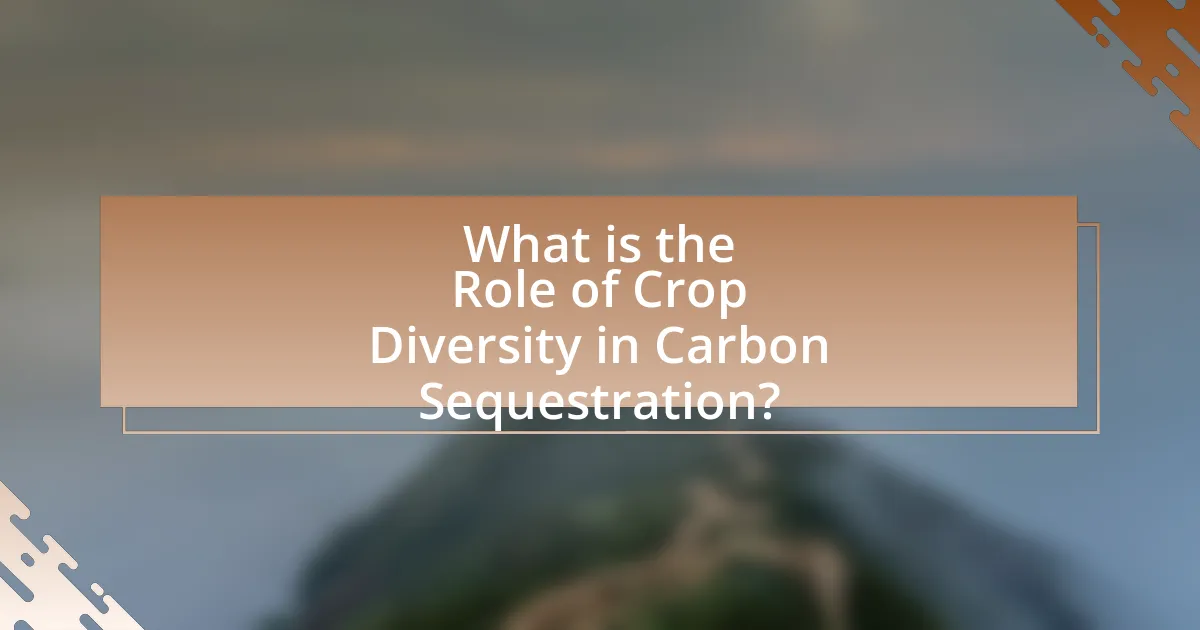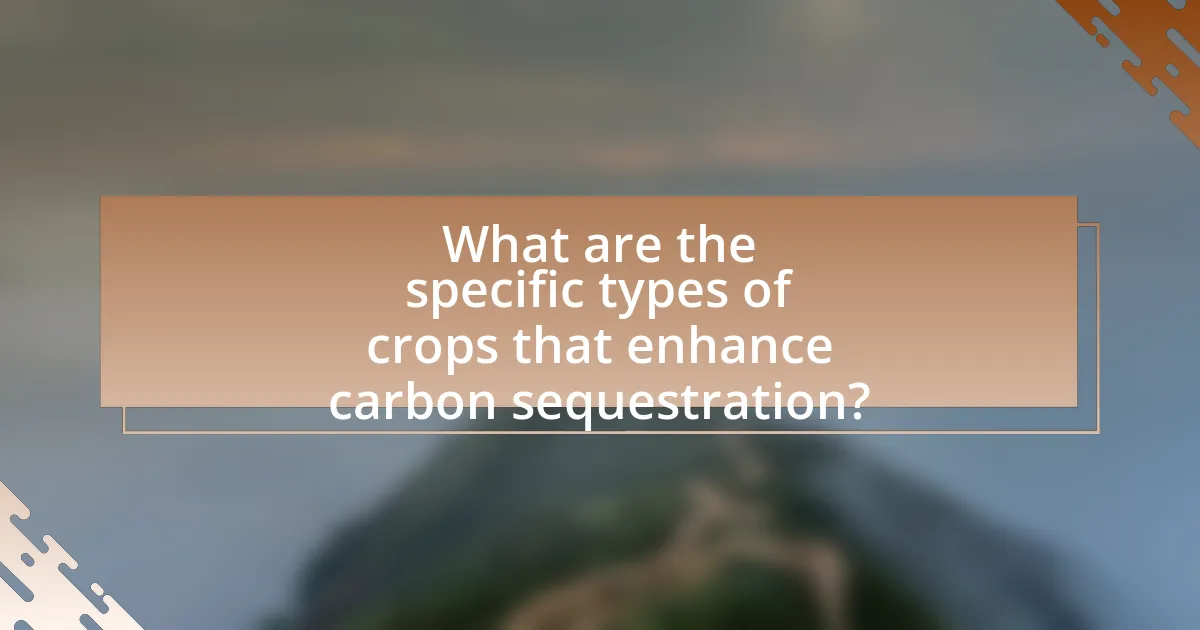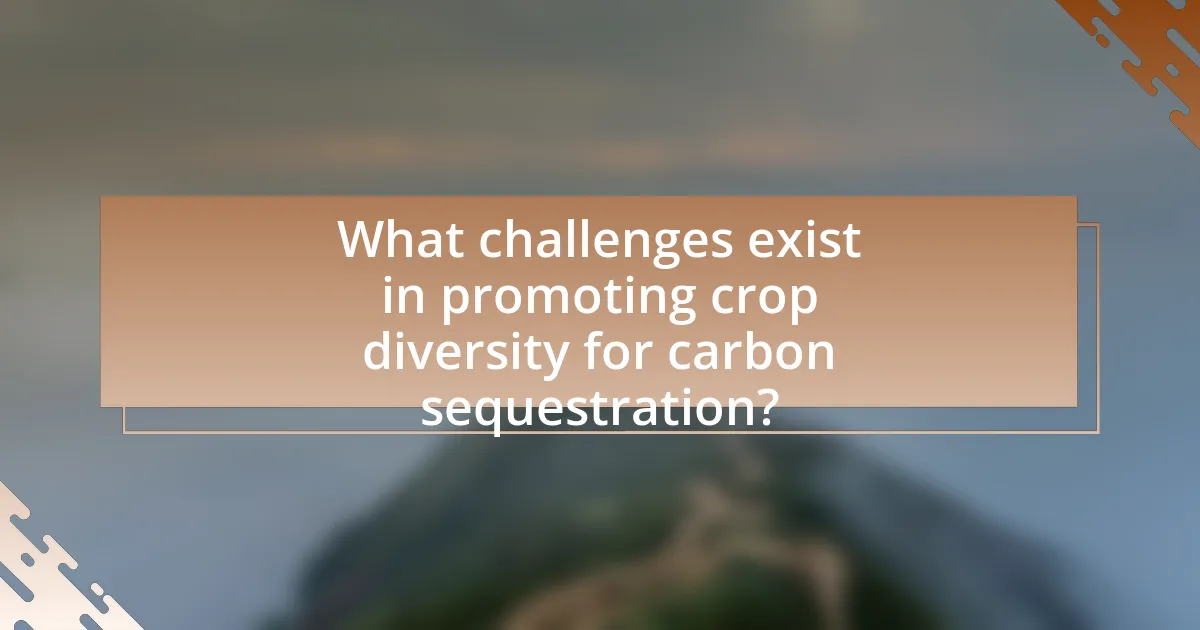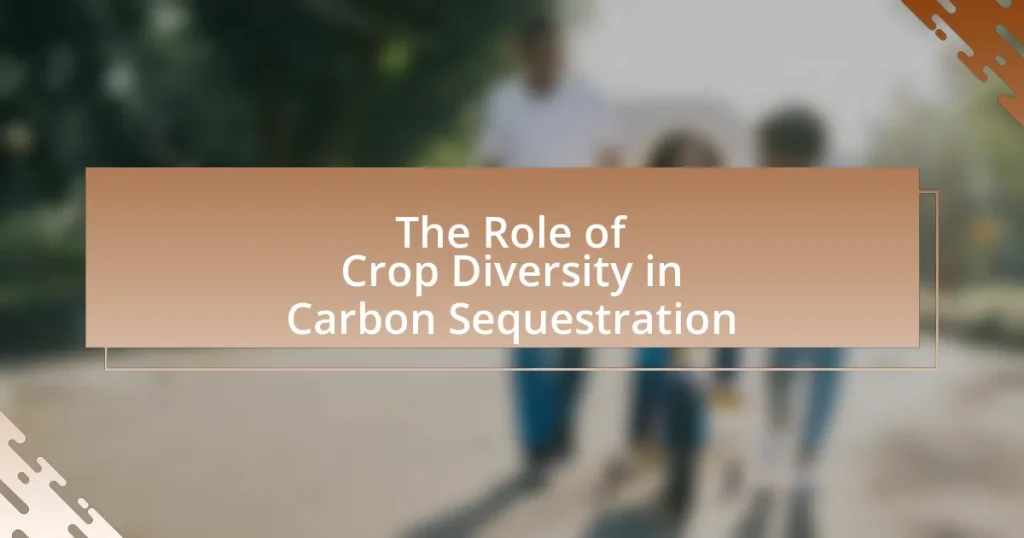Crop diversity is a crucial factor in carbon sequestration, significantly enhancing soil health and biomass production. Research indicates that diverse cropping systems can sequester up to 30% more carbon than monocultures by improving soil structure, microbial activity, and root biomass diversification. The article explores the mechanisms through which crop diversity contributes to carbon storage, the ecological and economic benefits of maintaining diverse crops, and the challenges faced in promoting these practices. It also highlights specific crops that enhance carbon sequestration and discusses best practices for implementing crop rotations and intercropping to maximize soil carbon levels.

What is the Role of Crop Diversity in Carbon Sequestration?
Crop diversity plays a significant role in carbon sequestration by enhancing soil health and increasing biomass production. Diverse cropping systems improve soil structure and microbial activity, which are crucial for carbon storage. Research indicates that polycultures can sequester up to 30% more carbon compared to monocultures due to their ability to utilize different soil layers and resources more efficiently. Additionally, varied root structures from different crops contribute to deeper soil carbon storage, further enhancing the soil’s capacity to sequester carbon over time.
How does crop diversity contribute to carbon sequestration?
Crop diversity contributes to carbon sequestration by enhancing soil health and increasing biomass production. Diverse crops improve soil structure and microbial activity, which leads to greater organic matter accumulation. Studies indicate that fields with higher crop diversity can sequester up to 30% more carbon in the soil compared to monoculture systems. This is supported by research from the University of California, which found that diverse cropping systems promote deeper root growth, allowing for more carbon storage below ground.
What mechanisms are involved in carbon sequestration through diverse crops?
Carbon sequestration through diverse crops involves several mechanisms, including enhanced soil organic matter accumulation, root biomass diversification, and improved nutrient cycling. Diverse crops contribute to increased soil organic carbon by promoting a variety of root structures that enhance soil aggregation and stability, leading to greater carbon storage. For instance, studies have shown that intercropping systems can increase soil organic carbon levels by up to 30% compared to monocultures due to the complementary root systems that capture more carbon. Additionally, diverse cropping systems improve nutrient cycling through varied plant residues, which support a wider range of soil microorganisms that facilitate organic matter decomposition and nutrient release, further enhancing carbon sequestration.
How does soil health relate to crop diversity and carbon storage?
Soil health is directly linked to crop diversity and carbon storage, as healthy soils support a wider variety of crops, which in turn enhances carbon sequestration. Diverse crops contribute to improved soil structure, increased organic matter, and enhanced microbial activity, all of which promote soil health. Research indicates that diverse cropping systems can increase soil organic carbon levels by 10-20% compared to monocultures, as seen in studies conducted by the Rodale Institute. This increase in organic carbon not only improves soil fertility but also enhances the soil’s ability to store carbon, thereby mitigating climate change effects.
Why is crop diversity important for sustainable agriculture?
Crop diversity is important for sustainable agriculture because it enhances ecosystem resilience, improves soil health, and increases productivity. Diverse crops can better withstand pests, diseases, and climate variability, reducing the need for chemical inputs and promoting natural pest control. Research shows that farms with higher crop diversity can yield up to 20% more than monocultures, as diverse root systems improve soil structure and nutrient cycling. Additionally, diverse cropping systems contribute to carbon sequestration by increasing organic matter in the soil, which is vital for mitigating climate change.
What are the ecological benefits of maintaining crop diversity?
Maintaining crop diversity provides significant ecological benefits, including enhanced resilience to pests and diseases, improved soil health, and increased biodiversity. Diverse crops can better withstand environmental stressors, reducing the risk of total crop failure. For instance, a study published in the journal “Nature” found that diverse cropping systems can reduce pest outbreaks by up to 50% compared to monocultures. Additionally, varied root structures from different crops improve soil structure and nutrient cycling, leading to healthier soils. Research from the Food and Agriculture Organization indicates that crop diversity can enhance ecosystem services, such as pollination and nutrient retention, which are vital for sustainable agriculture and carbon sequestration.
How does crop diversity enhance resilience against climate change?
Crop diversity enhances resilience against climate change by increasing ecosystem stability and adaptability. Diverse crops can better withstand extreme weather events, pests, and diseases due to their varied genetic traits. For instance, a study published in the journal “Nature” found that fields with higher crop diversity showed a 20% increase in yield stability under climate stress compared to monocultures. This resilience is crucial as climate change leads to more frequent and severe weather patterns, making diverse cropping systems essential for sustainable agriculture and food security.

What are the specific types of crops that enhance carbon sequestration?
Specific types of crops that enhance carbon sequestration include cover crops such as legumes, grasses, and brassicas. Legumes, like clover and vetch, fix atmospheric nitrogen and improve soil health, leading to increased organic matter and carbon storage. Grasses, such as rye and sorghum, have deep root systems that contribute to soil carbon accumulation. Brassicas, including radishes, help break up compacted soil and enhance microbial activity, further promoting carbon sequestration. Research indicates that integrating these crops into agricultural systems can significantly increase soil organic carbon levels, with studies showing increases of up to 1.5 tons of carbon per hectare per year in diverse cropping systems.
Which cover crops are most effective for carbon storage?
Leguminous cover crops, such as clover and vetch, are most effective for carbon storage due to their ability to fix atmospheric nitrogen and enhance soil organic matter. Research indicates that these crops can increase soil carbon levels significantly; for instance, a study published in the journal “Agriculture, Ecosystems & Environment” found that leguminous cover crops can sequester up to 1.5 tons of carbon per hectare annually. Additionally, deep-rooted cover crops like radishes and turnips contribute to carbon storage by improving soil structure and promoting microbial activity, further enhancing carbon sequestration capabilities.
How do legumes contribute to soil carbon levels?
Legumes contribute to soil carbon levels primarily through their ability to fix atmospheric nitrogen and enhance organic matter content. This process occurs as legumes form symbiotic relationships with nitrogen-fixing bacteria, which convert atmospheric nitrogen into a form usable by plants. As legumes grow, they produce biomass that, when decomposed, adds organic carbon to the soil. Research indicates that legumes can increase soil organic carbon levels by 0.5 to 1.5 tons per hectare annually, depending on the specific legume species and environmental conditions. This increase in organic matter not only improves soil structure and fertility but also enhances the soil’s capacity to sequester carbon over time.
What role do perennial crops play in long-term carbon sequestration?
Perennial crops significantly enhance long-term carbon sequestration by maintaining root systems that store carbon in the soil over extended periods. Unlike annual crops, which require replanting each season and often lead to soil disturbance, perennial crops establish deep root networks that contribute to soil organic matter and improve soil structure. Research indicates that perennial grasslands can sequester up to 1.5 to 2.5 times more carbon than annual cropping systems due to their ability to capture carbon year-round and reduce soil erosion. This sustained carbon storage is crucial for mitigating climate change and promoting soil health.
How do crop rotations impact carbon sequestration?
Crop rotations enhance carbon sequestration by improving soil health and increasing organic matter. Diverse crop rotations lead to varied root structures and biomass, which contribute to greater soil carbon storage. Research indicates that fields with diverse crop rotations can sequester up to 30% more carbon compared to monoculture systems, as demonstrated in studies conducted by the USDA Agricultural Research Service. These practices not only promote microbial activity but also reduce soil erosion, further supporting long-term carbon retention in agricultural systems.
What are the best practices for implementing crop rotations?
The best practices for implementing crop rotations include selecting diverse crops, planning rotations based on crop families, and incorporating cover crops. Diverse crops enhance soil health and reduce pest and disease pressure, as evidenced by studies showing that crop diversity can lead to a 20-30% increase in yield stability. Planning rotations according to crop families helps prevent nutrient depletion and pest cycles, while cover crops improve soil structure and organic matter, contributing to carbon sequestration. Research indicates that these practices can significantly enhance soil carbon storage, supporting the role of crop diversity in mitigating climate change.
How does crop rotation affect soil microbial communities?
Crop rotation significantly enhances soil microbial communities by promoting biodiversity and improving soil health. Different crops contribute varied organic matter and root exudates, which support diverse microbial populations. Research indicates that rotating crops can increase microbial biomass and activity, leading to improved nutrient cycling and soil structure. For instance, a study published in “Soil Biology and Biochemistry” by Hu et al. (2018) found that crop rotation increased the abundance of beneficial bacteria and fungi, which are crucial for soil fertility and carbon sequestration. This diversity in microbial communities ultimately leads to more resilient ecosystems capable of better carbon storage.

What challenges exist in promoting crop diversity for carbon sequestration?
Promoting crop diversity for carbon sequestration faces several challenges, including economic constraints, knowledge gaps, and policy limitations. Economic constraints arise as farmers may prioritize high-yield monocultures over diverse cropping systems due to immediate financial returns. Knowledge gaps exist regarding the best practices for implementing diverse cropping systems that effectively enhance soil carbon storage. Additionally, policy limitations can hinder the adoption of crop diversity, as existing agricultural policies often favor conventional farming methods, making it difficult for farmers to transition to more diverse practices. These challenges collectively impede the potential benefits of crop diversity in sequestering carbon effectively.
What are the economic barriers to adopting diverse cropping systems?
The economic barriers to adopting diverse cropping systems include high initial investment costs, market access limitations, and the risk of reduced short-term yields. Farmers often face significant expenses related to purchasing seeds for multiple crop varieties, implementing new farming practices, and acquiring necessary equipment. Additionally, limited access to markets for diverse crops can hinder profitability, as many farmers rely on established monoculture crops that have guaranteed buyers. Furthermore, the transition to diverse cropping systems may lead to lower yields in the initial years, creating financial uncertainty and discouraging farmers from making the switch. These factors collectively contribute to the reluctance to adopt diverse cropping systems despite their potential benefits for carbon sequestration and ecosystem health.
How can farmers overcome these economic challenges?
Farmers can overcome economic challenges by adopting crop diversity practices that enhance resilience and profitability. Implementing diverse cropping systems can lead to improved soil health, increased yields, and reduced dependency on chemical inputs, which collectively lower production costs. Research indicates that farms practicing crop rotation and intercropping can experience yield increases of 20-30% compared to monoculture systems, as diverse crops can better utilize resources and mitigate pest pressures. Additionally, diversifying crops can open new markets and reduce risks associated with price fluctuations, thereby stabilizing farmers’ income.
What policies support crop diversity and carbon sequestration?
Policies that support crop diversity and carbon sequestration include agroecological practices, conservation agriculture, and government incentives for sustainable farming. Agroecological practices promote biodiversity by encouraging crop rotation and intercropping, which enhance soil health and increase carbon storage. Conservation agriculture, which emphasizes minimal soil disturbance, cover cropping, and crop diversity, has been shown to improve soil organic carbon levels. Additionally, government incentives, such as subsidies for farmers who adopt sustainable practices, further encourage the implementation of these policies. For instance, the European Union’s Common Agricultural Policy provides financial support for practices that enhance biodiversity and carbon sequestration, demonstrating a commitment to sustainable agriculture.
How do government incentives influence crop diversity practices?
Government incentives significantly enhance crop diversity practices by providing financial support and resources that encourage farmers to adopt diverse cropping systems. These incentives, such as subsidies, grants, and tax breaks, lower the economic risks associated with transitioning from monoculture to polyculture, thereby promoting biodiversity. For instance, a study by the Food and Agriculture Organization (FAO) indicates that countries offering financial incentives for sustainable agricultural practices see a marked increase in crop diversity, which is essential for improving soil health and enhancing carbon sequestration. This correlation demonstrates that government policies can effectively drive the adoption of diverse cropping methods, ultimately contributing to environmental sustainability and climate change mitigation.
What practical steps can farmers take to enhance crop diversity for carbon sequestration?
Farmers can enhance crop diversity for carbon sequestration by implementing crop rotation, intercropping, and cover cropping practices. Crop rotation involves alternating different crops in the same field across seasons, which improves soil health and increases organic matter, leading to higher carbon storage. Intercropping, or growing multiple crops simultaneously in the same area, promotes biodiversity and enhances ecosystem resilience, which can further sequester carbon. Cover cropping, where farmers plant crops that are not intended for harvest, helps protect soil from erosion, improves soil structure, and adds organic matter, all contributing to increased carbon sequestration. Research indicates that diverse cropping systems can sequester up to 30% more carbon compared to monoculture systems, demonstrating the effectiveness of these practices in enhancing carbon storage in agricultural landscapes.










